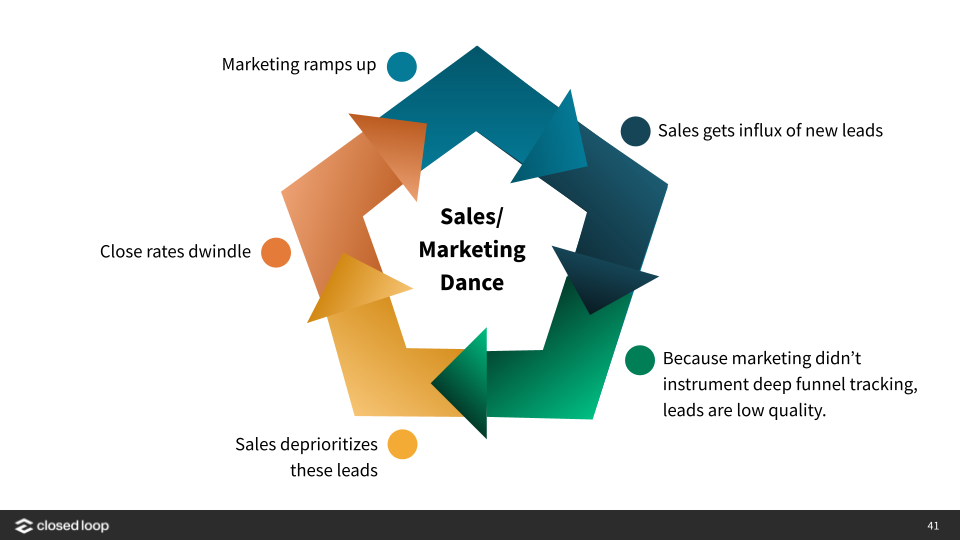B2B marketing is hard.
I’ve spent nearly 20 years in demand generation, mostly in the B2B arena. Within that time, I’ve conducted hundreds of audits from large and small B2B companies, from startups to mature companies.
And what continues to shock me is most of the struggles companies face are entirely internal. Here are five common ways B2B companies make it harder for themselves and their potential.
While this may seem harsh, B2B marketing creative today is subpar across many verticals and industries.
Earlier this year, the LinkedIn B2B Institute conducted a study of 1600 different B2B companies to determine their effectiveness. Their research concluded there is a significant crisis of creativity in B2B advertising.
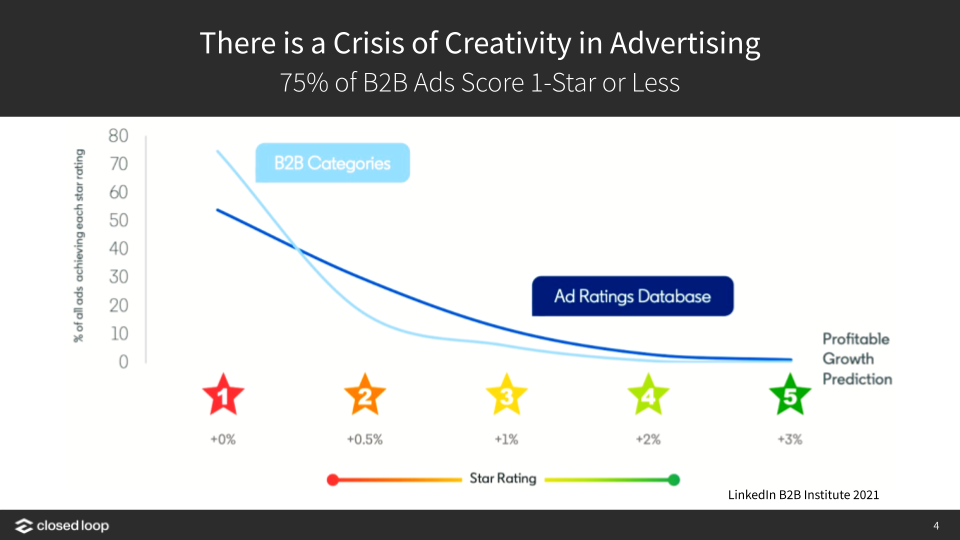
In their study, 75% of B2B ads scored one star or less, indicating zero effectiveness in long-term market share growth. Surprisingly, no B2B ads scored five stars. However, plenty of b2c ads scored five stars.
In my own audit research across clients, the trend continues. And, I’ve observed frequently internal issues are the root issue.
Often, B2B companies don’t have strong creative nor do they value it.
The lack of prioritization for creative strategy is especially common with leaner organizations in the SaaS space. Often, B2B companies are product-technology driven and not marketing driven like their B2C counterparts.
As a result, creative is usually a last thought. It also isn’t uncommon to hear clients say they have a part-time designer or freelancer that can throw together a couple of banner ads. And when creative isn’t developed strategically by a subject matter expert, you get subpar results.
Here’s an example of B2B ad examples within a competitor group in the financial services domain:
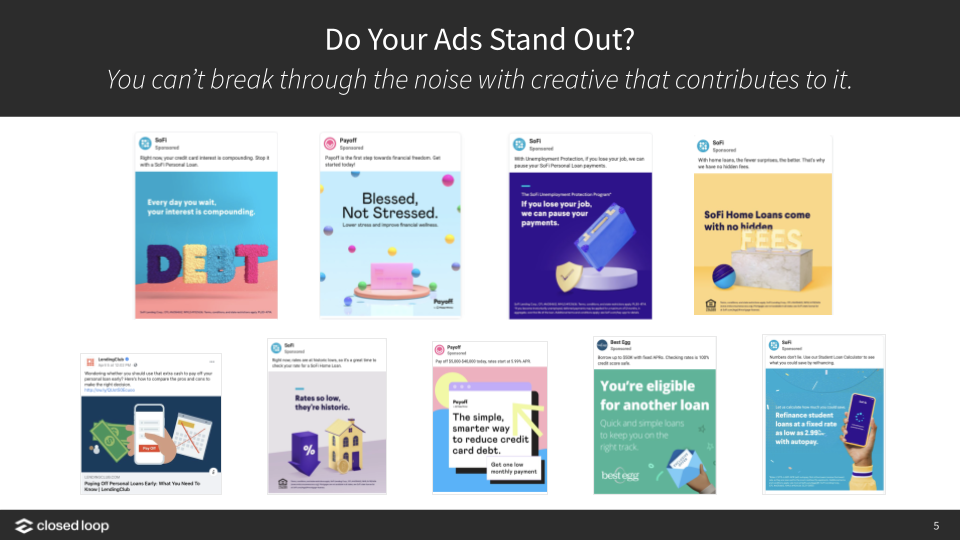
Above, none of the ads stand out from one another. If the name of the company was removed, you would never be able to guess these ads were different companies.
Unfortunately, they all look the same, making it harder for each of these brands to stand out from the crowd.
You can’t break through noise with creative contributing to it.
When it comes to approaching creative strategically, brands should aim to stand out from their competition. To determine that, compare your ads side by side with your competitors’ ads and evaluate whether your creative holds its own in a sea of sameness.
Next, assess the value of your ad to the end user. In the model below, each quadrant pertains to a different advertiser goal.
Typically, B2B advertisers want to increase demand and differentiate. To achieve these goals, advertisers should reinforce function—product features, benefits and outcomes.
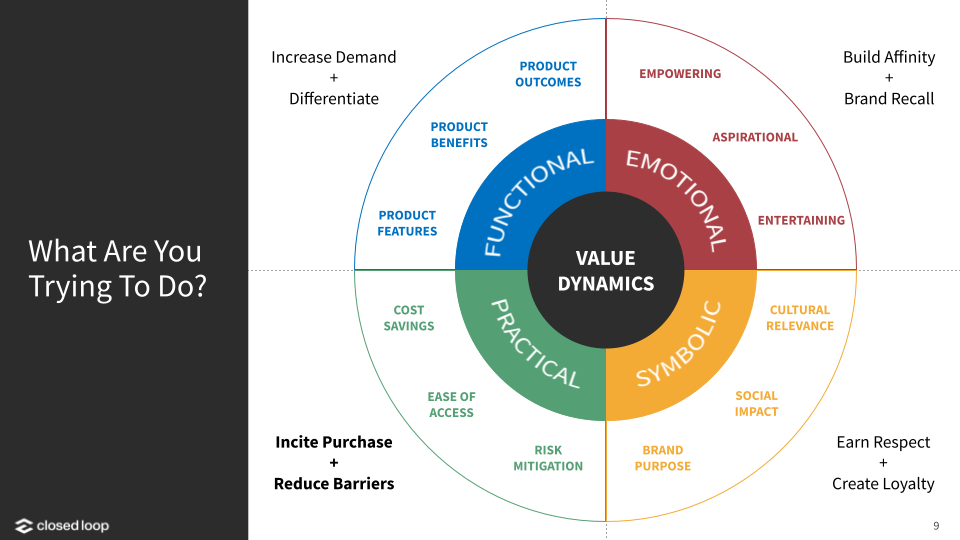
If a company desires to build their brand affinity and recall, appeal to emotions via entertainment, aspiration and empowerment.
When setting out to earn respect or create loyalty, brands should use symbolic creative by elevating brand purpose, social impact or cultural relevance.
At the bottom of the funnel when inciting purchase and barrier reduction is vital, it’s important for brands to close the deal by emphasizing the practical nature of their product or service, such as cost savings, risk mitigation and ease of use.
Most B2B advertisers operate in at least two of these quadrants, which is fine. However, it would be best if you had an adequate mix of those areas, especially after assessing what your competition is prioritizing.
Creative also falls short when mapping audience, intent and offer. In our audits, we observe many instances where product marketing develops an offer like a free trial, and demand generation pushes that offer out to all of their target audiences, without regard to where their audience is in their customer journey or funnel stage.
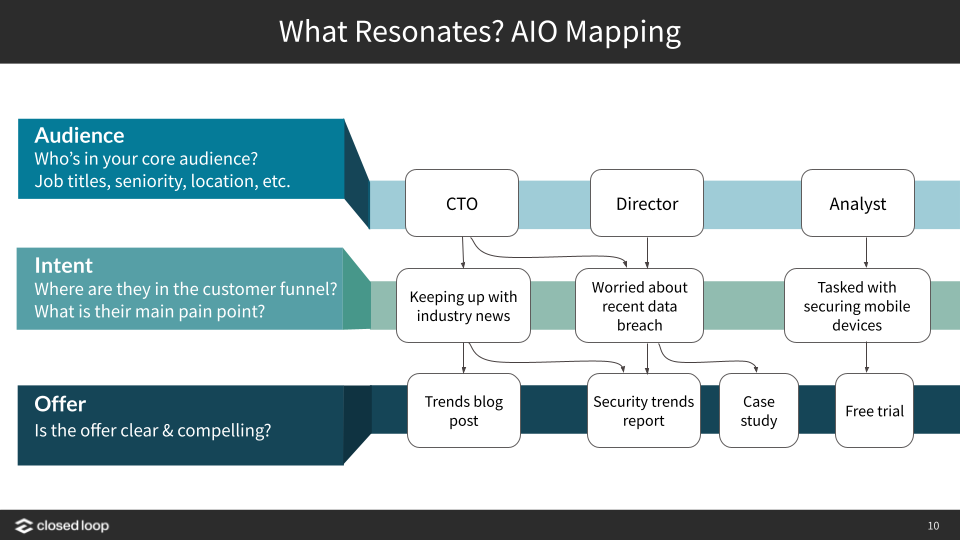
For example, if you’re looking to attract the c-suite, a free trial offer won’t be engaging to your desired audience. Executive-level associates care about trends and evolving landscapes. Hence, why it is imperative your offer matches your audiences’ intent. If you’re looking to acquire meetings, free trials and product demo offers would be your best bet.
Good ad creative also has to have a reason to make a user click. And that’s why it’s important to remember that effective creative speaks to a person, not a company.
Advertisers should execute on a story arc, characters, soundtrack, emotion and fluent device to resonate with their audience.
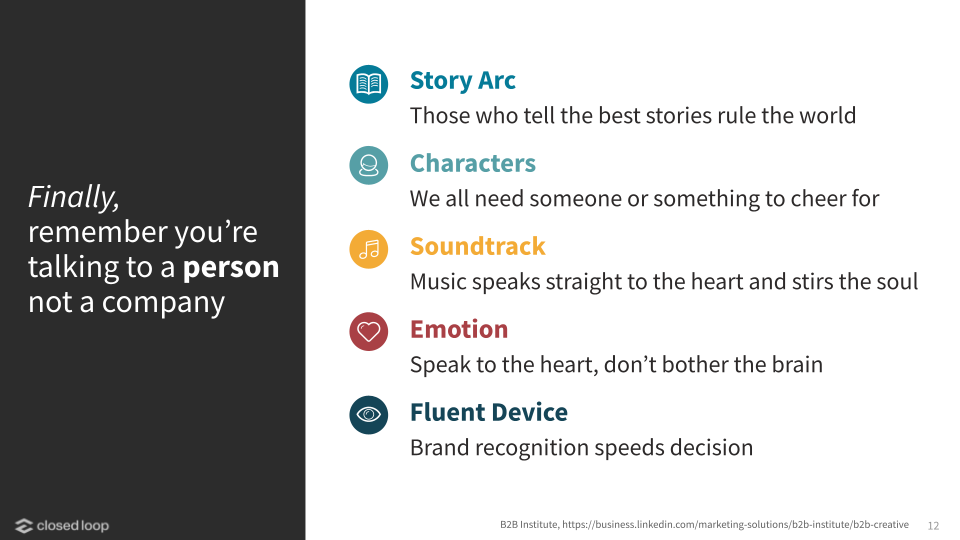
The next way we see B2B marketers standing in their own ways is not having visibility in ad spend. Too often, we hear stories about demand gen teams sending over leads to the sales team only to be informed they didn’t convert to opportunity or closed/won.
Nearly all of our B2B audits have the same problem. When we ask whether teams have tracking set up to see performance down to the keyword, ad and audience level to see which leads convert, the responses are almost always:
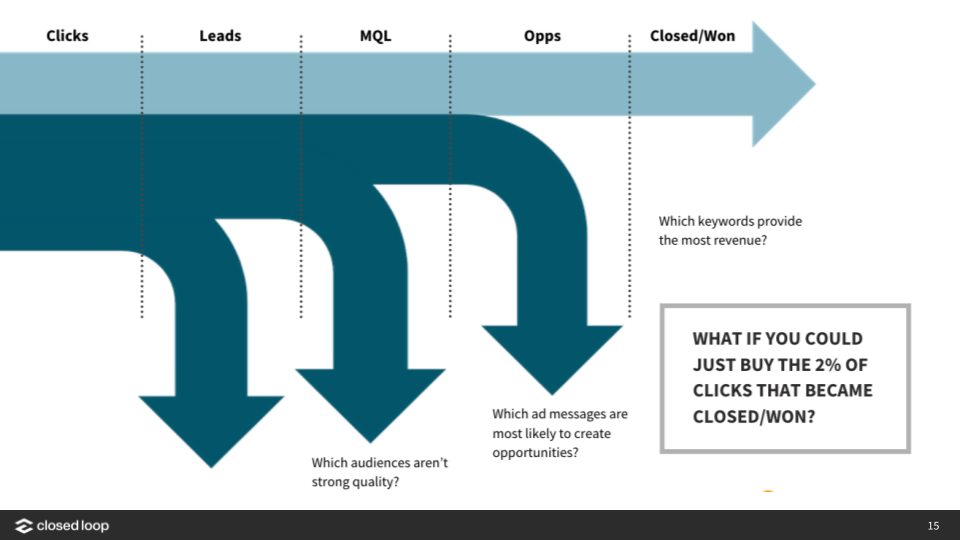
Advertisers can’t get traction without having visibility to further optimize. Here’s why this should be a top priority:
We ran a test on Google between Campaign A and Campaign B, spending an equal amount of money. On the front end, Google tells us that Campaign A has a lower cost per lead than Campaign B.
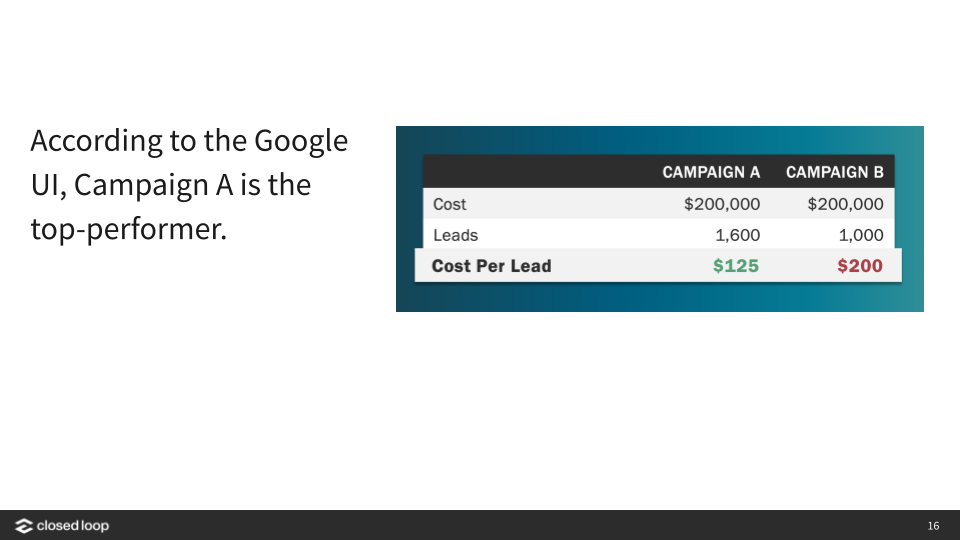
But backend reporting often tells a different story. Using dynamic UTMs, down-funnel metrics uncover where my MQLs, SQLs and opportunities are converting. Using smart bidding and allowing Google to continue to spend more dollars on Campaign A wouldn’t have uncovered the bigger picture around Campaign B—Campaign B drives more down-funnel activity at a lower cost per sale, hurting my return on ad spend.
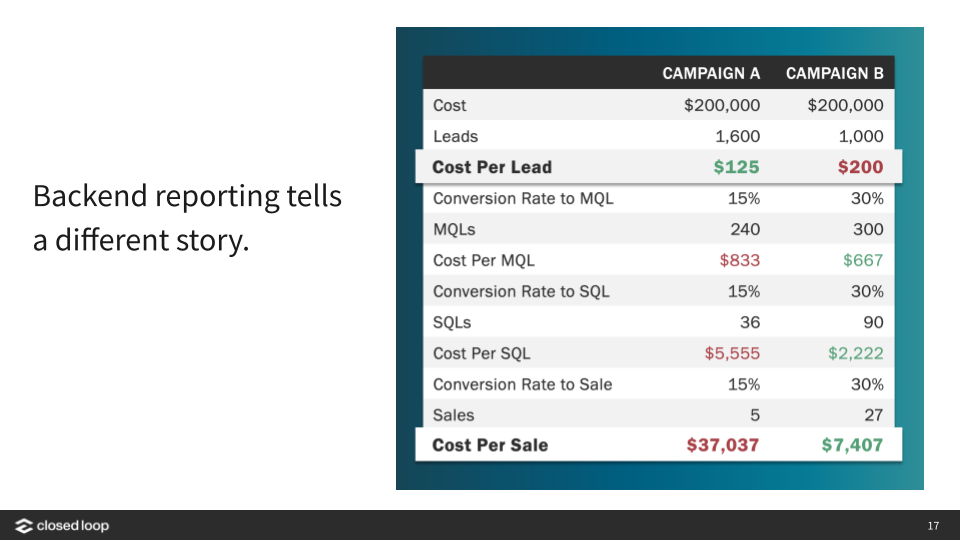
And while some brands may have tracking partially implemented into their campaigns, it’s still not good enough. Whether you have visibility at the campaign, ad group or key world level, advertisers and demand gen teams need the whole picture to gauge their campaigns’ performance.
Settling for initial vanity metrics and thin data can lead to ineffective spending. It’s critical to get granular and optimize toward deeper funnel metrics.
To get started tracking your campaigns’ performance effectively:
Well-intentioned B2B marketers hoard data.
Even with the industry buzz around collecting first-party data, many marketers aren’t using the information to its full capability. They’re sitting on it.
While the focus to collect first-party data is important, it’s equally as important to use it. In many of the audits I’ve seen, we often see a basic use of first-party data:
There are two ways to use your first-party data. The first is targeting—segmenting your customer data and sending it to platforms.
Platforms can then use those lists for retargeting or to build lookalike models. The second way is for optimization. Uploading your backend lead data as “offline conversions” for use in optimizing and machine learning.
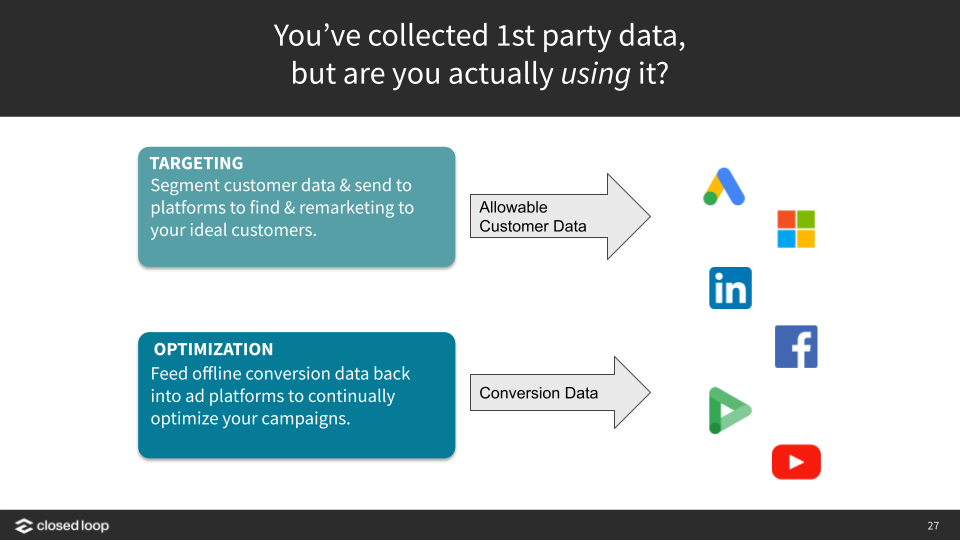
As of now, at least Google, Bing, LinkedIn, Facebook, DV360, and YouTube take in this first-party data. More and more are popping up every day.
Using your first-party data to target is easier than you might think. There are marketing automation integrations between CRMs and ad Platforms that allow us to easily target high-value lists that we already own and from there, build similar or lookalike audiences off of those lists.
This integration improves lead quality, serves ads to key audiences and provides a more relevant ad experience for the user. And it isn’t cookie-based so it’s a great retargeting tactic that works around the changes coming.
For example, we can ensure users are seeing the right message based on what Marketo list they belong to. This means you can change the messaging you serve a user based on where they are in the funnel.
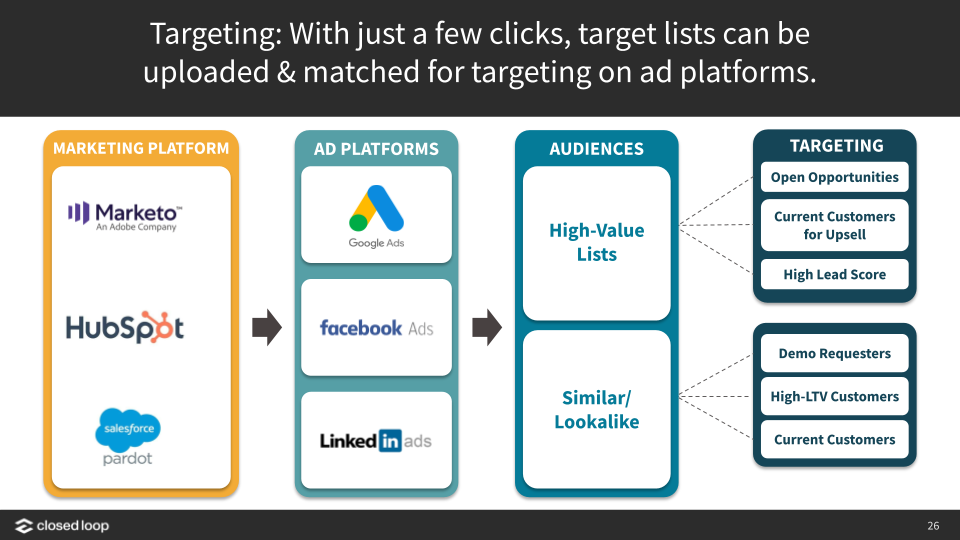
If they were once a part of a top of funnel list where they were served a brand video for awareness but now they take action and move down the funnel, you can use automation to update which list the user belongs to and serve them mid-funnel content to keep up with their journey.
I love this because you can base these lists off lead scores so if a user takes action offline or in an email or basically anywhere that isn’t an ad, and their lead score changes, and you can automatically serve them different content as they flow down the funnel and into different list segments.
Now, just a disclaimer that the lists in the ad platforms won’t update automatically but it is certainly possible to update them everyday. It really only takes a few button clicks to get them updated and pushed over. Hopefully automation is coming down the road though!
On large teams, requesting list pulls can take time and multiple people to get the job done and this integration is relatively painless. Since they’re so easy to update, audiences won’t see irrelevant messaging just because you haven’t updated the list in a while.
Using a process similar to I described before in passing back UTMs, you can use your first-party data to optimize your campaigns.
Using first-party data for optimization is going to be critical in the next few months to one year as cookies go away. Getting used to feeding your data back into the ad platforms for optimization and using machine learning should be top priority.
There are a couple of different ways to do it. First and foremost, you want to capture the click ID or in the case of LinkedIn and Facebook capture, email, phone and name that gets stored into the CRM or internal database. Then, you can upload it.
Sometimes during upload, marketers get stuck due to lack of resources for server integration. In this event, start out with just the manual upload. While it won’t be perfect, you’ll still be on your way to server integration as you get buy-in from your dev team to have a comprehensive solution.
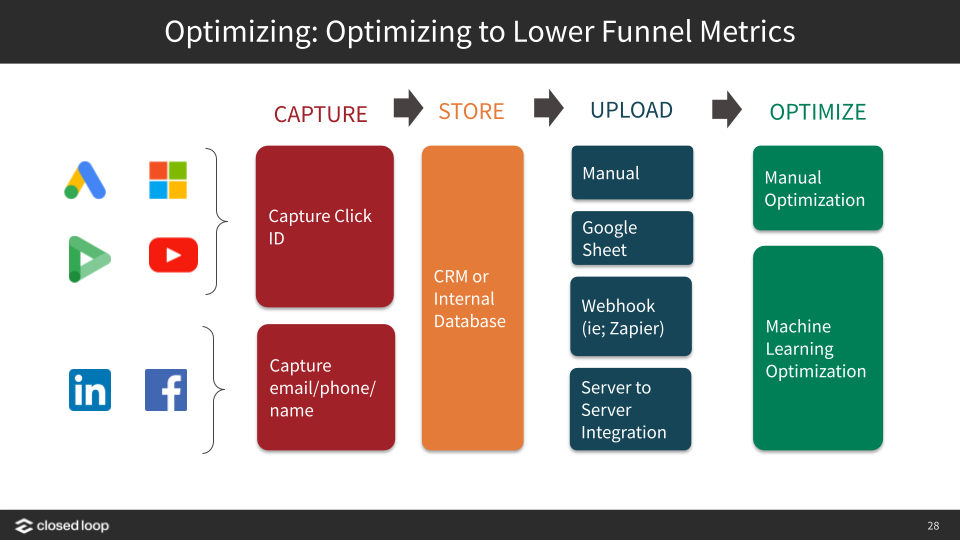
Some of you might be familiar with the Bass Diffusion Model of Growth. Essentially, the formula for growth results in a nice S-curve as shown here. But what is important, is that Bass found that when advertising is started early, there is a faster growth rate in the early years, leading to a higher level of sales when things stabilize.
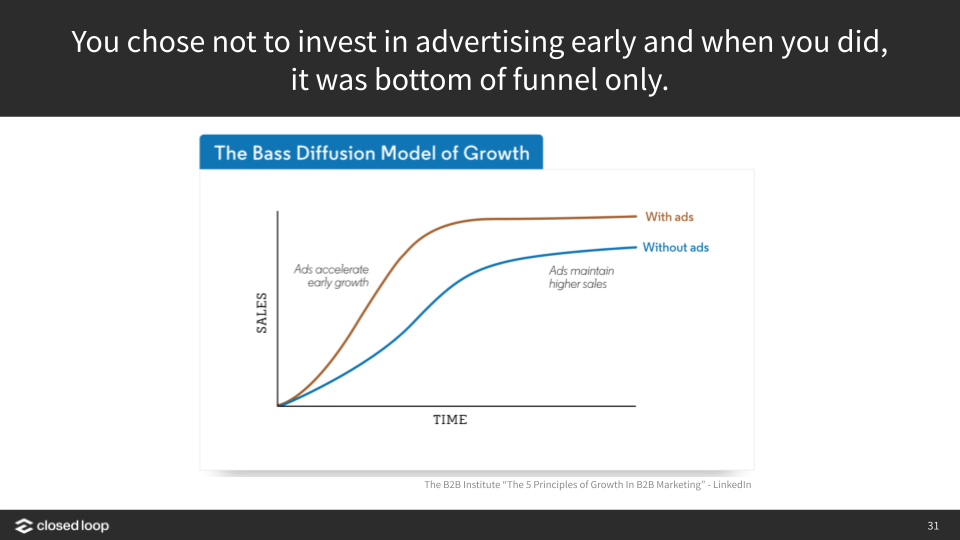
Brands that have no awareness typically chose not to invest in advertising early. And when they did, it was bottom-of-the-funnel only. In our research, we’ve discovered that even the most stable brands are reluctant to invest in brand awareness, despite it being critical to growth.
To understand why this is true, you have to look at B2B buying behavior. As you know, B2B buyers are typically risk averse and buying is done largely by committee.
Initial consideration sets are more than twice as likely to win business compared to brands not in the initial consideration set, per a McKinsey study. It’s vital to get in the initial consideration set early on in the journey.
According to Gartner, B2B buyers are using search social and video in the early and mid funnels to identify brands in their initial consideration set. If you’re not on search, social and video early, you’re late to an already crowded party.
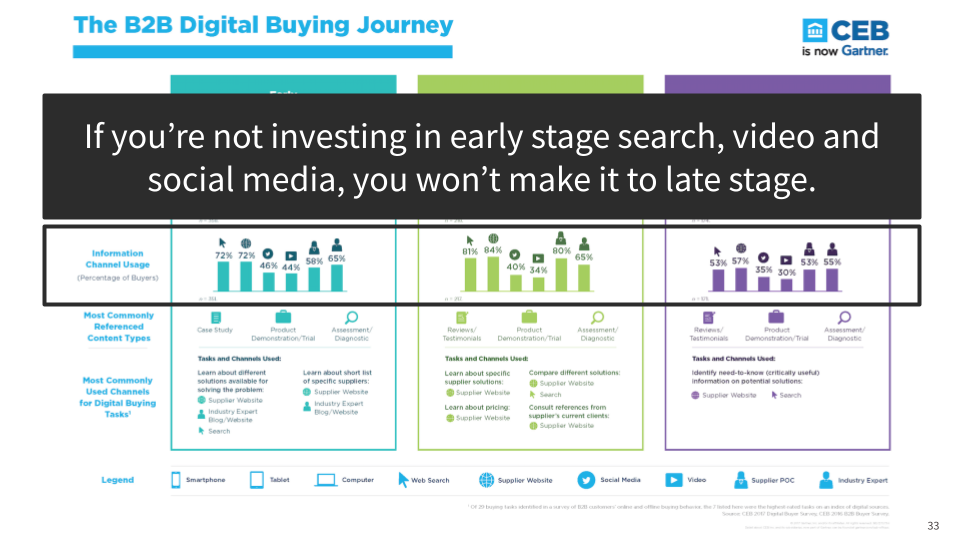
Too many marketers don’t invest in brand awareness because they need to hit a certain cost per lead. Sometimes goals cloud marketers from following their intuition about the need for top-of-funnel marketing.
But the following case study illustrates why top-of-funnel initiatives are just as important to the bottom line. Here’s what happens when you stop viewing your paid marketing dollars in a silo.
This client below had been extremely careful to educate the CEO, the CFO & others in the company to view results in aggregate and not in siloes.
The result is over 700% growth from an already established base.
Internally, they keep a consistent CPL based on marketing dollars/all leads. They’ve done this because they know that market spend affects all channels, not just paid channels.
To prove this, this chart is a client’s leads by month for organic, paid, referrals and direct.
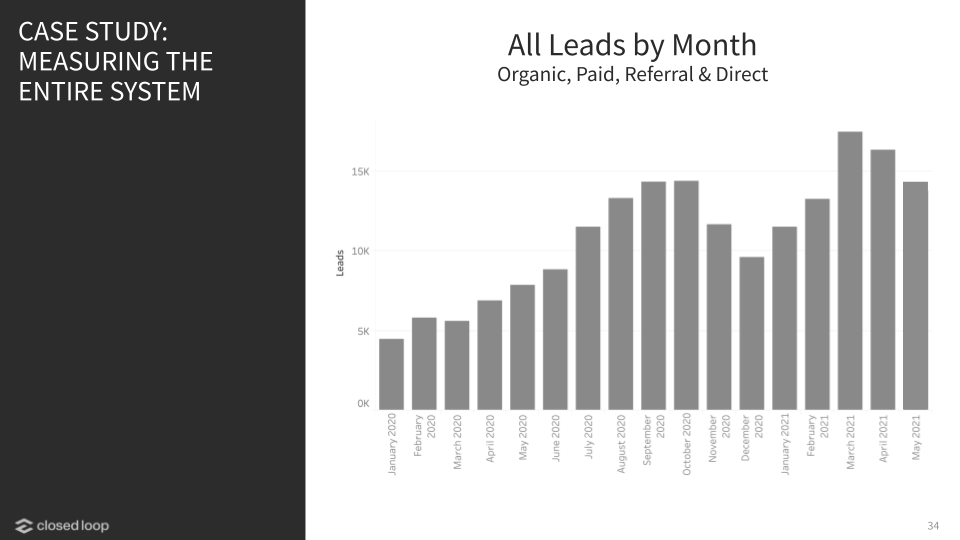
We can break the chart down into paid channels and unattributed (those that are either unknown sources, direct, organic or referrals).
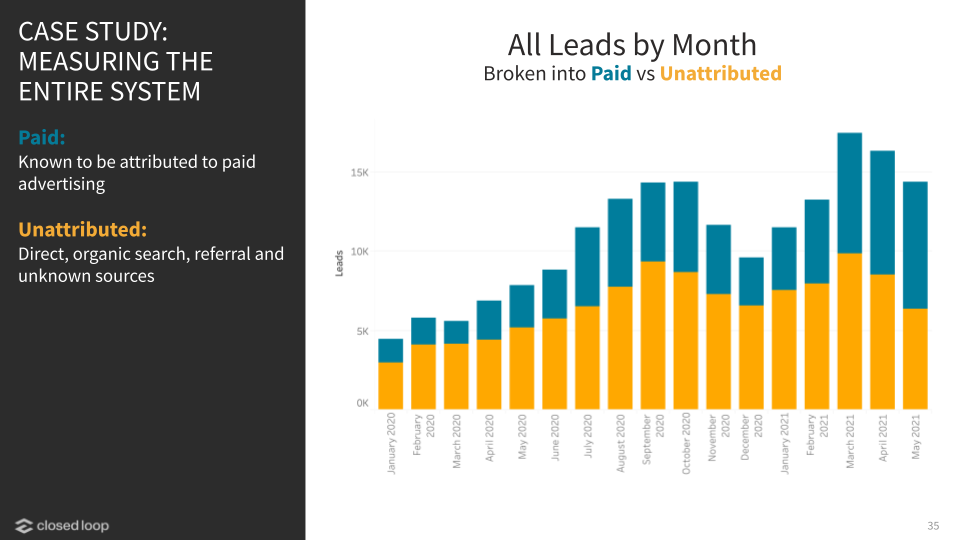
When we take away the paid leads, look at the unattributed and then overlay our marketing spend, we can see marketing spend had a profound impact on attributed leads. And this continued when marketing spend fell, so did the organic direct and referral leads.
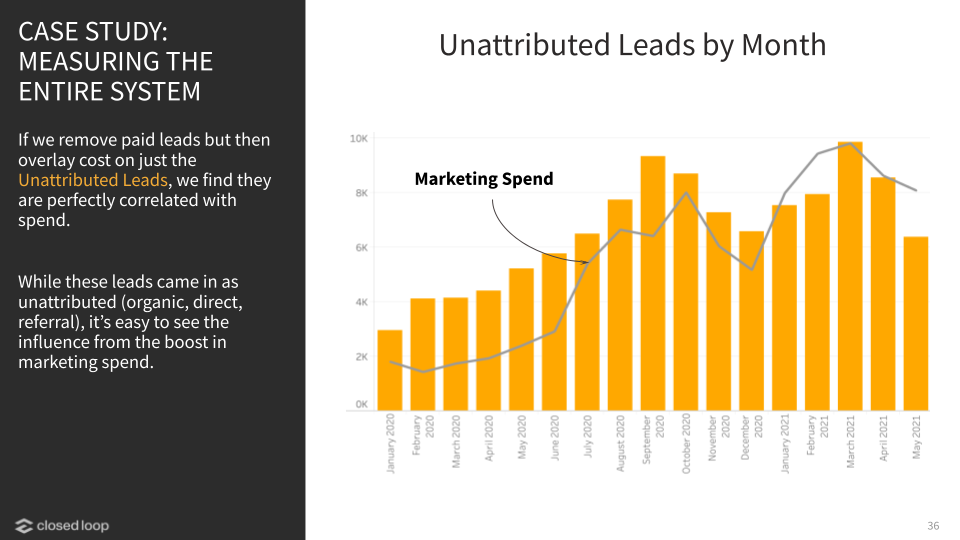
Don’t hesitate to scale your marketing spend to invest in brand awareness, while keeping a consistent cost per lead. The boost in unattributed leads will be well worth it.
Once upon a time, we had a program for a client that no matter what we tried we could not get any traction. It didn’t behave like any of our other Facebook lead generation campaigns or similar campaigns for other clients. We had a good budget allocated to it, CTRs were good, conversion to inquiry was good, but conversion to lead was terrible.
This program ran for 41 weeks, and we only saw some mediocre scale. Leads coming in were great quality, we just couldn’t get it to scale until early this year.
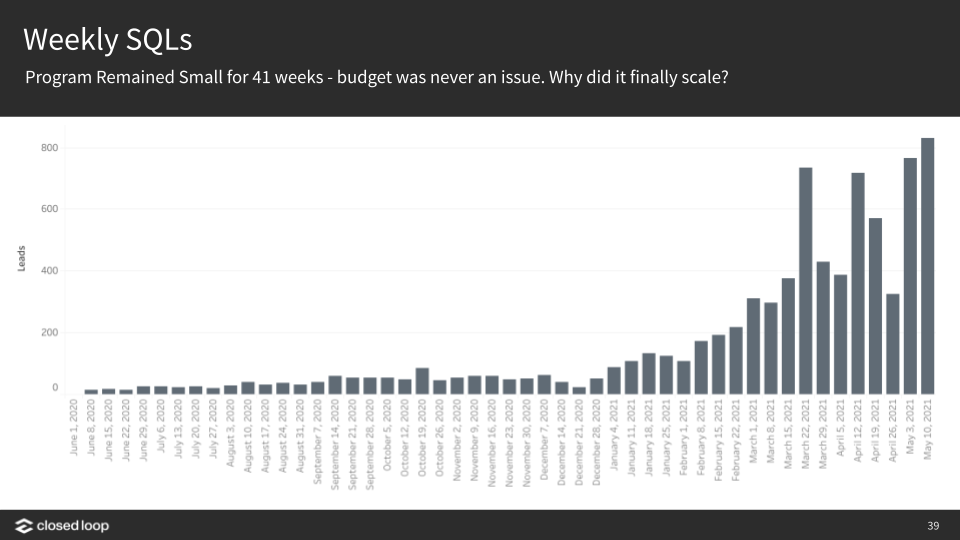
Why did it scale? We finally got access to sales records to show when the lead came in vs when sales was contacting them. This is what it looked like:
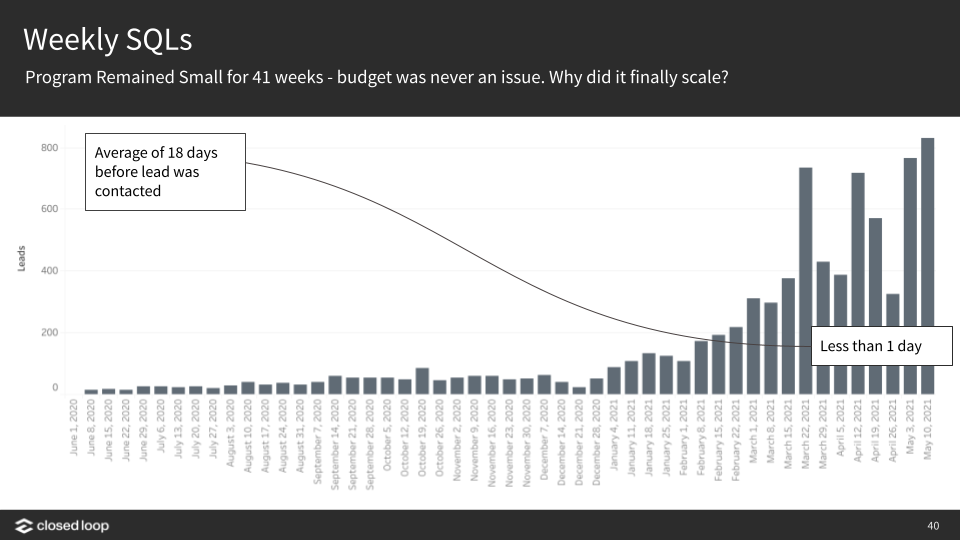
We discovered the sales team let leads sit for 18 days before making contact. By that time, the leads had gone cold and weren’t becoming opportunities. The client worked to create a separate sales team to respond to these leads quicker and now the program drives close to 1000 leads each week instead of just 5-10.
The reality….
If marketing doesn’t talk with sales, this dance will go on and on. Open the lines of communication, measure deep in the funnel and work TOGETHER to solve each other’s problems.
